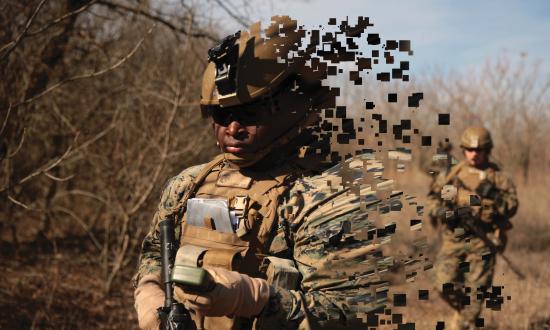Today’s information age requires a new kind of literacy beyond the ability to read and write. Reports, news stories, and articles often use data, graphs, and statistics to support a conclusion—usually with little explanation of the data analysis methods used. To make better-informed decisions, naval officers need to be able to evaluate whether the use of data was appropriate or misleading. They need data literacy.
The National Academies of Sciences, Engineering, and Medicine believe all students should have “the ability to understand data, to make good judgments and good decisions with data, and to use data analysis tools responsibly and effectively.” Called data acumen, these skills encompass data literacy and include ten major concepts:
• Mathematical foundations
• Computational foundations
• Statistical foundations
• Data management and curation
• Data description and visualization
• Data modeling and assessment
• Workflow and reproducibility
• Communication and teamwork
• Domain-specific considerations
• Ethical problem solving1
A Proposed Requirement
The three primary naval officer commissioning sources—the U.S. Naval Academy, Naval Reserve Officer Training Corps (NROTC), and Officer Candidate School/Officer Development School (OCS/ODS)—have no specific graduation requirement for data literacy. Students are required to complete some math coursework, including calculus, and some majors require probability and statistics and differential equations, but data literacy is not guaranteed.
Table 1 proposes a data literacy requirement that could be appended to existing academic commissioning requirements. A data literacy requirement should capture many elements of data acumen but also remain somewhat broad to allow different types of courses to satisfy the requirement. Statistics, probability, data science, and visual analytics are four subjects that could satisfy a one semester or quarter course requirement.
Statistics is the science of gathering, describing, and analyzing data.2 It studies parameters of populations and the ability to make inferences about populations based on a sample. Students learn how to systematically evaluate claims with hypothesis testing and to communicate their results precisely.
Probability is the study of randomness and uncertainty.3 It is concerned with determining the mathematical likelihood of an outcome occurring when many outcomes are possible. A well-known application of probability is determining the chances of rolling dice or winning card games. A probability course can be helpful in many warfighting disciplines. For example, an understanding of probability is an essential skill for officers trying to determine the location of a survivor in a search-and-rescue scenario. It also is invaluable in an antisubmarine warfare scenario, where the location of a submarine is frequently expressed as a probability.
Data science is concerned with the ability to gain insights from large data sets. Students learn how to wrangle data, manage data, gain intuition, and make predictions from data. Data science is often taught with a technical emphasis in computer coding, but spreadsheet-based analysis also could be performed.
Visual analytics is “the science of analytical reasoning facilitated by interactive visual interfaces.”4 Visual analytics could be an alternative to a traditional math or coding course. It teaches students to interact with data and communicate data analysis results to others. It creates understandable pictorial insights from data in charts, graphs, or diagrams. Communicating results visually is a skill many officers use throughout their careers.
Every Officer Data Literate
Naval officers need to be able to make decisions based on an overload of information. Some of the data they can expect to encounter includes text, numeric data, databases, images, probabilities of a possible occurrence, statistics from a sample, sensor data, and video data. Multiple types of data may be encountered simultaneously, and all of it must be analyzed together to gain insight. This presents a challenge, as data may be large, ambiguous, uncertain, diverse, and potentially deceptive.5
Naval officers rely on information and data analysis provided by others to develop a set of beliefs about a situation. These beliefs are vulnerable to interpretation and the quality of the information on which they are based. Misleading information can result in poor conclusions. Officers must be data literate to defend against a persuasive but erroneous data-based argument, to decrease vulnerability to pseudoscience and lessen the chances of making bad decisions.6 A basic understanding of data literacy can teach future officers to recognize when data analysis occurs in a report and whether the analysis should be further scrutinized.
Former Chairman of the Joint Chiefs of Staff Admiral Michael Mullen described why every officer needs to understand data. In a 2010 interview, Admiral Mullen explained how his education in operations research helped him understand real-world problems and develop policy:
In a very tough situation, how do we war-game out several steps into what [things] might look like if we adopt a certain policy? Underpinning it, I think, with good models, good data . . . is something we have to do more and more of so that the best decisions can be made.7
Admiral Mullen also pointed out that future leaders cannot simply rely on a computer or system to give an adequate representation of all the data in a situation. He added, “We don’t have systems, we don’t have enough money, to be able to create universal situational awareness with sensors. The world’s too big.”8 The Navy cannot expect future leaders to be presented a perfect representation of data to understand a tactical setting.
Former Chief of Naval Operations Admiral John Richardson believes a challenge in the near future will be for leaders to be able to orient themselves in a data-rich environment. In a 2017 speech, he noted, “Sifting through all that data to be able to rapidly understand the operational environment and discern those changes is now going to be the critical part of orienting.”9 Future naval leaders must be comfortable interacting with large amounts of data to understand the battlespace.
Those who can comprehend and use data the best will have a competitive advantage. Admiral Richardson explained, “In an era in which CubeSats are being launched into space, and zettabytes of information are available, the advantage boils down to not who gets the information, but who can make the better sense of it. Who can orient themselves better, and make the better decision.”10
Leaders need to filter huge amounts of data and come to the right conclusions to make good decisions. Making sense out of data will be an essential skill for every future naval officer.
Everyone wants more data, but the sheer volume of data that can be obtained will have the potential to overwhelm a decision maker. The successful future naval officer must know the data elements that are needed, filter out the rest, and rely on data literacy skills such as probability, statistics, data science, and visual analytics to infer the complete battlespace.
1. National Academies of Sciences, Engineering, and Medicine, Data Science for Undergraduates: Opportunities and Options (Washington, DC: The National Academies Press, 2018), 12, 22–31.
2. C. Warren, K. Denley, and E. Atchley, Beginning Statistics, 2d ed. (Mount Pleasant, SC: Hawkes Learning, 2014), 3.
3. J. L. Devore, Probability and Statistics for Engineering and the Sciences, 9th ed. (Boston: Cengage, 2016), 52.
4. J. J. Thomas and K. A. Cook, Illuminating the Path (Hoboken, NJ: Wiley–IEEE Press, 2005), 28.
5. Thomas and Cook, Illuminating the Path, 25.
6. J. S. Hawkes, Discovering Statistics and Data, 3d ed. (Mount Pleasant, SC: Hawkes Learning, 2018), 25.
7. P. Horner and B. List, “Q & A: Admiral Mike Mullen: Armed with Analytics,” Analytics Magazine 3, no. 5 (September/October 2010): 31–36.
8. Horner and List, “Q & A: Admiral Mike Mullen,” 32.
9. D. Thornton, “CNO Warns about ‘Changing Character’ of Military Competition,” Federal News Radio, 15 June 2017.
10. Thornton, “CNO Warns about ‘Changing Character’ of Military Competition.”








